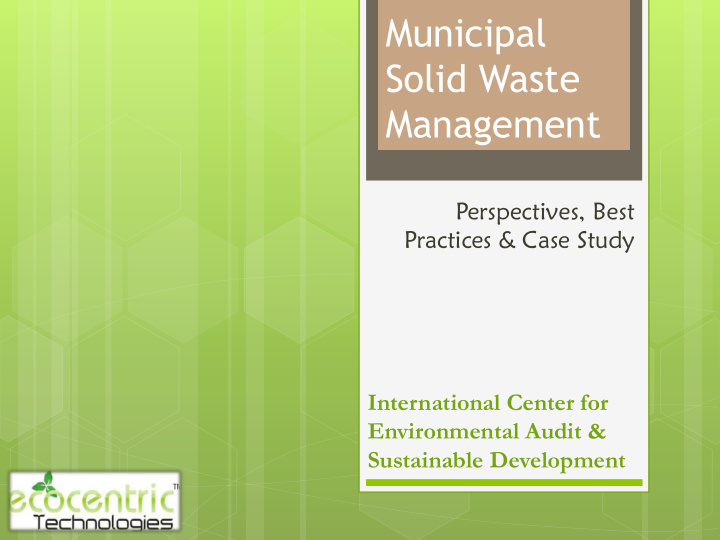



Municipal Solid Waste Management Perspectives, Best Practices & Case Study International Center for Environmental Audit & Sustainable Development
Components of Municipal Solid Waste Physical Composition of Indian Composition of waste Household waste is an important factor in developing any Biodegradables intervention Paper 19% 53% Plastics/Rubber Though the 4% composition of waste Metal 5% 8% varies geographically, Glass 1% a large component of Indian HH waste still Rags 9% 1% remains Other Biodegradable Inert
Rules pertaining to MSWM Came into effect in the year 2000 through a Supreme Court intervention The Rules, applicable to every Municipal authority, lay down guidelines for effective waste management system in context to Indian scenario. Municipal authority responsible for any infrastructure development for collection, storage, segregation, transportation, processing and disposal of municipal solid wastes. Littering of municipal solid waste prohibited in cities, towns and in urban areas Door to Door Collection of waste from all commercial and domestic waste generation points. Collection vehicle shall be containerized Proper waste collection schedule notified by Municipal authority
Rules pertaining to MSWM Community awareness program for primary segregation of waste at source Covered, hygienic facility for storage of waste Color coding of storage facility Biodegradable waste – Green Recyclable – White/Blue Inert - Black Covered Vehicle to be used for T ransportation of waste Avoid Multiple Handling of waste Suitable, low cost technologies, in context to waste component, to be adopted for processing of waste Biodegradable - Vermicomposting/aerobic Digestion Recyclable – Pelletization Inert – Scientific Landfilling Waste processing site and Landfill shall be away from any habitation clusters and shall be a no-development zone All important measures for pollution abatement, as laid down, shall be strictly complied with
Hierarchy of Waste Management System Municipal Corporation Policy Making Executive Powers Municipal Council Standing Committee Municipal Commissioner Mayor/President Chairman Municipal Secretary Administration Geographical Functional Classification Classification Chief Auditor Engineering Health Zones Finance Circles Town Planning Wards Revenue
Present Methodology Municipal Corporation Tendering Process Waste Processing Landfill Management Waste Collection & Transportation Private Agency Private Agency Private Agency
Problem in Design Linear, Centralized Model No Regulatory Mechanism Stakeholders left unattended Lack of Customization while designing the model Zero Community Participation leads to Lack of ownership in the waste producer Lack of ownership in the workers Disenchantment amongst all stakeholders
Problem in Implementation Fault in Design leads to Fault in Implementation Lack of technical expert => everyone becomes expert Lack of technical expertise => huge financial losses Lack of technical expertise => No coordination WM still perceived as cleaning of area Zero accountability of authorities and the implementing agency
Best Practices Identify the issues at local level Group discussion & brainstorming with experts Action plan for an area Implementation Monitoring and evaluation Overcoming the lacuna Model making Implementation on a larger scale
Process Flowchart Household Waste Non- Biodegradable biodegradable Recyclable Inert Waste Composting Waste Used for agriculture Recycling Landfill and landscaping
Door to Door Collection Open Body Hydraulic Tipper Six Container Tricycle Closed Tipping Bodies with two Compartments
Waste Transportation
Street Sweeping Two shifts Workers with protective Gears Skill training to workers Women employment generated Working in hygienic conditions Using long handled brooms Equipment with best ergonomic designs Minimum Occupational Hazards
Visible Sign Marks for IEC activities Clear sign boards Cooperation with Local MC Sign boards about road sweeping
Proper Garbage Bins
Area based customization
Processing Technologies
Processing and Landfilling Landfill Site Landfill Site Vermi Compost Plant Vermi Compost Plant
Processing and Landfilling After PPP Before PPP
Recommend
More recommend